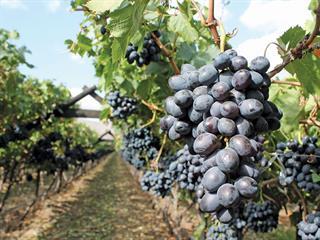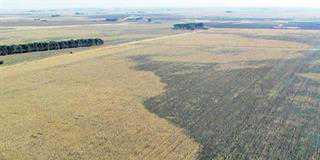
No two vineyard blocks are alike. To produce top quality table grapes, a farmer has to understand the individual needs of each vineyard block on a farm, says Pieter Joubert of Buffelskraal farm in De Doorns. “You have to really get to know your vineyards. Each block requires different treatment from the next.”
It is this attitude of dedication and attention to detail that helped Pieter produce the winning block in this year’s Hex Valley Table Grape Association Block Competition. The competition has been running since 1976. Farmers who compete are judged on the quality of viticulture practices such as planting density, trellising and pruning as well as the appearance of grapes in the block entered.
Background
Pieter was born and raised on the family farm Buffelskraal in De Doorns. On joining his father Pierre here in 2012, he became the fourth generation of Jouberts to produce table grapes on the 20ha farm. After finishing school he decided to gain work experience and learn more about the table grape packaging and export industry. He began by working at HexPak, a commercial packhouse in De Doorns, from 2008 to 2009.
He then shifted to table grape production and worked as farm manager for Leon Viljoen on De Vlei farm in De Doorns for two years. “Leon was a very good teacher. I learned everything I know about growing grapes from him and my father,” says Pieter.
When he started farming with his father in 2012, the process of replanting older grape varieties with seedless ones was well under way on the farm. According to Pieter, they replace up to 10% of their vineyards every year and their replanting strategy has recently focused on new, seedless varieties to satisfy market demand.
They grow mainly the red, seedless varieties Crimson Seedless and Sweet Celebration, and have also planted the red seedless variety, Allison Seedless, a white seedless variety, Sweet Globe and a black, seedless grape, Autumn Royal.
“We’re busy replacing the last of our older varieties, Red Globe and Dauphine, which together still make up about 15% of our total grape plantings,” says Pieter.
All their grapes are for export and they market exclusively through marketing company EXSA, which works closely with its producers to develop a market-driven growing approach.

Pieter Joubert
The winning block
The block of Crimson Seedless that earned Pieter first place in the category for established vineyard blocks in the competition was planted in 2007. The vines were planted at a density of 1m (between plants) by 3m (inter-row) using the gable or double-slanted trellis system. At planting, the soil preparation for the block included a once-off application of 1t/ ha gypsum. The annual fertiliser programme is determined according to a soil analysis conducted every three years.
For this season, between budding and flowering, the winning block received two applications of 150kg/ ha each of nitrogen fertiliser in the form of LAN when the shoots were 15cm and 50cm long. Pieter aims for 1m-long shoots at the time flowering starts. At 50% flowering, they spray the vineyards with 10kg/ha urea and at veraison (ripening), they apply 80kg/ha of potash using KCL (potassium chloride) fertiliser.
According to him, they follow a standard, preventative spraying programme to keep pest and disease pressure under control. This includes spraying for funguses, most notably powdery and downy mildew, and for pests such as mealybug, thrips and stem borer. To help control pests, they also rely on vineyard monitoring.
Vineyard manipulations
The vines are pruned to have six long fruiting canes with 12 buds each. “Since our fruiting canes are positioned rather densely, when the shoots are about 30cm long, we sucker all the shoots without clusters – if it doesn’t have grapes on we take it off,” explains Pieter.
Canopy management, which regulates the amount of sunlight that penetrates through the leaves to the vines and fruit, is carried out continually and intensively. “We want the green shoots and the grape bunches to be exposed to some light, but not to too much direct sunlight,” he stresses.
Standing between rows, Pieter points towards the canopy of leaves: “You see there are no dark areas where too many leaves were left to form too heavy a cover, but there are no big gaps between the leaves either.” To promote branch thinning and bigger berry size, Pieter sprays gibberellic acid (GA). The first application is done at 120% flowering. This, explains Pieter, is when all the bunches have fully flowered and some bunches have already finished doing so.
The GA application is intended to boost bunch thinning. When applied during flowering, GA also stimulates elongation of the bunches. Pieter’s team girdles the vine trunks to encourage berry enlargement when the berries are about 4mm to 5mm in diameter. This is followed by a second, manual GA application when the berries are 6mm to 8mm in size. For this application, the bunches are plunged by hand into a bucket containing a solution of GA, CPPU and Kelpak (seaweed extract) in water.
“It’s important to prune away inferior bunches as soon as possible so that you have a lighter load on the shoots,” he explains.
Between fruit set and when the berries swell to a pea-size (6mm to 8mm), bunches are pruned to about 15 to 20 bunches per vine and the retained bunches are shortened to between 10cm and 15cm. This is also the time for topping the shoots, and they cut off the ends of the shoots “to help the vines focus on growing the grapes”, says Pieter.
The Jouberts aim to produce extra-large berries and to qualify for this class the Crimson Seedless berries must be at least 18mm in diameter. The average size of grapes from the block that won the block competition this year was about 20mm.
Pieter says that they expect to pack out approximately 6 000 trays/ ha (4,5kg each) from the winning block; this amounts to 27t/ha.
Grape colour
“We have heavy, clay soils and aim to produce high yield. As a result, the grapes struggle to develop colour,” he explains.
To promote colouring, they spray the fruit with ProTone and Ethephon, plant growth regulators that enhance colour. The first application takes place at 5% to 10% veraison. For this, Pieter uses 2kg ProTone and 500ml Ethephon. The second application occurs seven days later; here, Pieter uses 1kg ProTone and 400ml Ethephon.
For both applications Pieter mixes in 50ml of Villacrop’s Villa 51, a surfactant that increases the wetting and spreading properties of spray solutions and ensures that all the berries are properly treated. The ProTone, Ethephon and Villa 51 mixture is sprayed with a fish-tail spray tank at a rate of 500l of water/ha.
Irrigation
The Jouberts make use of a micro irrigation system and DFM probes to measure plant-available water in the soil pores. This enables them to manage a good air- water balance in the soil to promote root development and nutrient uptake and reduce unwanted plant stress and soil compaction.
The probes measure plant water use in the root zone. The readings incorporate all the factors influencing plant water use, such as plant size and evaporation, soil water potential, drainage and runoff, making the system highly efficient and user-friendly. The probes help them use their water resources effectively, eliminating over- and under-watering.
“The vines should never suffer any water stress – this can be detrimental to the crop,” says Pieter. “We usually irrigate from the middle of September until April. During peak production time we apply about 50mm of water per week over six to seven hours.”
Employees
Pieter believes one of the keys to success is a disciplined, dedicated and well-trained workforce. “An employer has to encourage workers to be optimistic and he should cultivate a good working relationship with his employees. At the end of the day it’s the work of their hands that ends up in the boxes and punnets.”
He stresses that the employees should understand how their work fits into the entire production process so that they can grasp the importance of every action. The Jouberts employ 30 permanent workers and during harvest season the total number of employees increases to about 45. Pieter stresses the importance of spending time with his employees and allowing them to get to know him.
“The only way to build trust is to openly and honestly communicate with your workforce,” he says.
His motto? “Be hard on the rules, but soft on the person.”
Email Pieter Joubert at [email protected].













